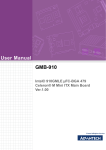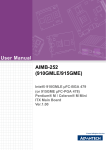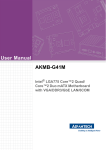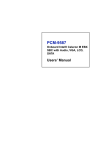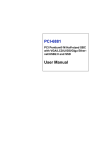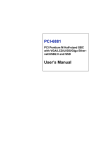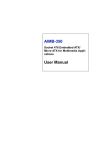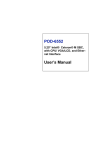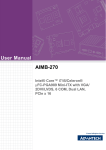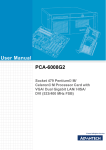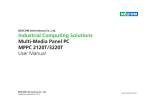Download Data Modul AG AIMB-258 User manual
Transcript
User Manual AIMB-258 Intel® GM45 µFC-PGA 478 Core™2 Duo Mini ITX Motherboard with VGA, DVI, LVDS, 6 COM, Dual GbE, 8 USB, 2 SATA II, PCIe x 16 Version June 2009 Data Modul AG - www.data-modul.com Safety Information Electrical safety ! ! ! ! ! ! To prevent electrical shock hazard, disconnect the power cable from the electrical outlet before relocating the system. When adding or removing devices to or from the system, ensure that the power cables for the devices are unplugged before the signal cables are connected. If possible, disconnect all power cables from the existing system before you add a device. Before connecting or removing signal cables from the motherboard, ensure that all power cables are unplugged. Seek professional assistance before using an adapter or extension cord. These devices could interrupt the grounding circuit. Make sure that your power supply is set to the correct voltage in your area. If you are not sure about the voltage of the electrical outlet you are using, contact your local power company. If the power supply is broken, do not try to fix it by yourself. Contact a qualified service technician or your retailer. Operation safety ! ! ! ! ! ! Before installing the motherboard and adding devices on it, carefully read all the manuals that came with the package. Before using the product, make sure all cables are correctly connected and the power cables are not damaged. If you detect any damage, contact your dealer immediately. To avoid short circuits, keep paper clips, screws, and staples away from connectors, slots, sockets and circuitry. Avoid dust, humidity, and temperature extremes. Do not place the product in any area where it may become wet. Place the product on a stable surface. If you encounter technical problems with the product, contact a qualified service technician or your retailer. Caution! The symbol of the crossed out wheeled bin indicates that the product (electrical and electronic equipment) should not be placed in municipal waste. Check local regulations for disposal of electronic products. AIMB-258 User Manual Part No. 2006025801 Edition 2 Printed in Taiwan June 2009 ii Certifications This device complies with the requirements in part 15 of the FCC rules: Operation is subject to the following two conditions: ! This device may not cause harmful interference, ! This device must accept any interference received, including interference that may cause undesired operation. This equipment has been tested and found to comply with the limits for a Class A digital device, pursuant to Part 15 of the FCC Rules. These limits are designed to provide reasonable protection against harmful interference when the equipment is operated in a commercial environment. This equipment generates, uses, and can radiate radio frequency energy and, if not installed and used in accordance with the instruction manual, may cause harmful interference to radio communications. Operation of this device in a residential area is likely to cause harmful interference in which case the user will be required to correct the interference at his/her own expense. The user is advised that any equipment changes or modifications not expressly approved by the party responsible for compliance would void the compliance to FCC regulations and therefore, the user's authority to operate the equipment. Caution! There is a danger of a new battery exploding if it is incorrectly installed. Do not attempt to recharge, force open, or heat the battery. Replace the battery only with the same or equivalent type recommended by the manufacturer. Discard used batteries according to the manufacturer's instructions. iii AIMB-258 User Manual Technical Support If a problem arises with your system and no solution can be obtained from the user’s manual, please contact your place of purchase or local distributor. Alternatively, please try the following help resources for further guidance. Visit the Advantech website for FAQ, technical guide, BIOS updates, driver updates, and other information: http://support.advantech.com.tw/Support/default.aspx Packing List Before you begin installing your single board, please make sure that the following materials have been shipped: ! 1 x AIMB-258 Intel® µFC-PGA 478 Core 2 Duo Mini ITX Motherboard ! 2 x SATA HDD cable ! 2 x SATA Power cable ! 1 x Serial port cable 1 to 4 ! 1 x I/O port bracket ! 1 x Startup manual ! 1 x Driver CD ! 1 x Warranty card If any of the above items is damaged or missing, please contact your retailer. AIMB-258 User Manual iv Contents Chapter 1 Product Introduction ...........................1 1.1 1.2 Before You Proceed.................................................................................. 2 Motherboard Overview.............................................................................. 2 1.2.1 Placement Direction...................................................................... 2 1.2.2 Screw Holes.................................................................................. 3 Motherboard Layout .................................................................................. 4 Figure 1.1 Motherboard Layout ................................................... 4 Specifications ............................................................................................ 5 Operating System support list ................................................................... 6 Board Diagram .......................................................................................... 7 Ordering Information ................................................................................. 8 Riser Card ................................................................................................. 8 Bracket View ............................................................................................. 8 Accessories............................................................................................... 8 Layout Content List ................................................................................... 9 Table 1.1: Jumper Setting List..................................................... 9 Table 1.2: JSETCOM1: COM1/+5 V/+12 V Selection ................. 9 Table 1.3: JSETCOM2: COM2 RS232/422/485 Mode Selection 9 Table 1.4: CMOS1: Clear CMOS .............................................. 10 Table 1.5: J1:LCD Power 3.3 V/5.5 V Selection........................ 10 Table 1.6: PSON1: ATX, AT Mode Selection ............................ 10 Table 1.7: JWDT1: Watchdog Timer Output Option.................. 11 Table 1.8: JOBS: HW monitor ................................................... 11 Central Processing Unit (CPU) for AIMB-258 ......................................... 11 1.12.1 Installing the CPU ....................................................................... 12 1.12.2 Installing the CPU Heatsink and Fan .......................................... 14 1.12.3 Uninstalling the CPU Heatsink and Fan...................................... 16 System Memory ...................................................................................... 17 1.13.1 DIMM Sockets Location .............................................................. 17 1.13.2 System Memory .......................................................................... 17 1.13.3 Memory Support List................................................................... 18 Table 1.9: SODIMM DDR3 ........................................................ 18 Connectors.............................................................................................. 19 1.14.1 Rear Panel Connectors............................................................... 19 Table 1.10: Rear Panel Connectors ............................................ 19 Table 1.11: LEDs......................................................................... 19 1.14.2 CPU Fan Connector (CPUFAN1) ............................................... 20 1.14.3 System Fan Connector (SYSFAN1, SYSFAN2) ......................... 21 1.14.4 Serial Port Connector 3456 (COM3456)..................................... 22 1.14.5 Front Headphone Connector (HD1)............................................ 22 1.14.6 Front Panel Connector (JFP1/JFP2/JFP3) ................................. 23 1.14.7 ATX soft power switch (JFP1 / PWR_SW) ................................. 23 1.14.8 Reset (JFP1 / RESET)................................................................ 23 1.14.9 HDD LED (JFP2 / HDDLED)....................................................... 23 1.14.10External speaker (JFP2 / SPEAKER) ......................................... 23 1.14.11Power LED and keyboard lock connector (JFP3 / PWR_LED&KEY LOCK) ................................................ 24 Table 1.12: ATX power supply LED status (No support for AT power) ........................................ 24 1.14.12USB 2.0 Connector (USB56, USB78)......................................... 24 1.14.13ATX Power Connector (ATX1).................................................... 25 1.14.14LCD Inverter Connector (VP1).................................................... 26 1.14.15LVDS Connector (LVDS1) .......................................................... 26 1.14.16Digital I/O Connector (DIO_CN1)................................................ 27 1.3 1.4 1.5 1.6 1.7 1.8 1.9 1.10 1.11 1.12 1.13 1.14 v AIMB-258 User Manual 1.14.17Serial ATA Connector 1 & 2 (SATA1, SATA2) ........................... 27 1.14.18PCIe x 16 Slot (PCIE X 16)......................................................... 28 1.14.19SPI Flash Connector(SPI_CN1) ................................................. 28 1.14.20Memory Connector Channel A/B(DIMM1/2) ............................... 29 1.14.21SPDIF1 out connector(SPDIF1) ................................................. 29 1.14.22CF connector .............................................................................. 30 Chapter 2 BIOS Operation ................................. 31 2.1 2.2 BIOS Introduction.................................................................................... 32 BIOS Setup ............................................................................................. 32 2.2.1 Main Menu .................................................................................. 33 2.2.2 Standard CMOS Features .......................................................... 34 2.2.3 Advanced BIOS Features ........................................................... 35 2.2.4 Advanced Chipset Features ....................................................... 36 2.2.5 Integrated Peripherals ................................................................ 37 2.2.6 USE Device Setting .................................................................... 39 2.2.7 Power Management Setup ......................................................... 40 2.2.8 PnP/PCI Configurations.............................................................. 42 2.2.9 PC Health Status ........................................................................ 42 2.2.10 Load Setup Defaults ................................................................... 43 2.2.11 Set Password.............................................................................. 43 3 Chipset Software Install Utility ........ 45 3.1 3.2 3.3 Before you Begin .................................................................................... 46 Introduction ............................................................................................. 46 Windows Vista/XP Driver Setup.............................................................. 47 4 VGA Setup ......................................... 49 4.1 4.2 Introduction ............................................................................................. 50 Windows Vista/XP Driver Setup.............................................................. 50 5 LAN Configuration ............................ 51 5.1 5.2 5.3 5.4 Introduction ............................................................................................. 52 Features.................................................................................................. 52 Installation............................................................................................... 52 Windows Vista/XP Driver Setup (Realtek RTL8111C)............................ 52 Appendix A Programming the Watchdog Timer . 55 A.1 Programming the Watchdog Timer ......................................................... 56 A.1.1 Watchdog timer overview ........................................................... 56 A.1.2 Programming the Watchdog Timer............................................. 56 Table A.1: Watchdog Timer Registers....................................... 58 A.1.3 Example Program ....................................................................... 59 Appendix B Pin Assignments............................... 63 B.1 USB Connector (USB56,USB78)............................................................ 64 Table B.1: USB5/USB6 Connector (USB56) ............................. 64 VGA Connector (VGA1A) ....................................................................... 64 Table B.2: VGA Connector (VGA1A)......................................... 64 Chapter Chapter Chapter B.2 AIMB-258 User Manual vi B.3 B.4 B.5 B.6 B.7 B.8 B.9 B.10 B.11 B.12 B.13 B.14 B.15 B.16 B.17 B.18 B.19 DVI Connector (VGA1B) ......................................................................... 64 Table B.3: DVI Connector (VGA1B)........................................... 64 RS-232 Serial Port (COM1~COM2) ........................................................ 65 Table B.4: RS-232 Serial Port (COM1~COM2) ......................... 65 RS-232 Serial Port (COM3 ~ COM6) ...................................................... 66 Table B.5: RS-232 Serial Port (COM23).................................... 66 PS/2 Keyboard/ Mouse Connector (KBMS1) .......................................... 67 Table B.6: PS/2 Keyboard/ Mouse Connector (KBMS1) ........... 67 CPU Fan Power Connector (CPUFAN1) ................................................ 67 Table B.7: CPU Fan Power Connector (CPUFAN1).................. 67 Power LED & Keyboard Lock Connector (JFP3) .................................... 68 Table B.8: Power LED and Keylock Connector (JFP3) ............ 68 HDD LED and External Speaker Connector (JFP2/HDD LED and SPEAKER)............................................................ 68 Table B.9: External Speaker Connector (JFP2/SPEAKER)....... 68 ATX Soft Power Switch and Reset Connector (JFP1/ PWR-SW and RESET) ................................................................ 69 Table B.10:Audio Front Panel Connector (JFP1/ RESET) ......... 69 Audio Front Panel Connector (FPAUD1) ................................................ 69 Table B.11:Audio front panel connector (FPAUD1) .................... 69 GPIO Pin Header (GPIO1)...................................................................... 70 Table B.12:GPIO Pin Header (GPIO1) ....................................... 70 LVDS Connector (LVDS1) ...................................................................... 71 Table B.13:LVDS Connector (LVDS1)........................................ 71 LVDS Power Jumper (J1) ....................................................................... 72 Table B.14:LVDS Power Jumper (J1)......................................... 72 LVDS Invert (VP1)................................................................................... 72 Table B.15:LVDS Invert (VP1) .................................................... 72 System I/O Ports ..................................................................................... 73 Table B.16:System I/O Ports ...................................................... 73 DMA Channel Assignments .................................................................... 73 Table B.17:DMA Channel Assignments...................................... 73 Interrupt Assignments ............................................................................. 74 Table B.18:Interrupt Assignments............................................... 74 1st MB Memory Map ............................................................................... 74 Table B.19:1st MB Memory Map ................................................ 74 vii AIMB-258 User Manual AIMB-258 User Manual viii Chapter 1 1 Product Introduction This chapter describes the main board features and the new technologies it supports. 1.1 Before You Proceed Take note of the following precautions before you install motherboard components or change any motherboard settings. Caution! ! ! ! ! ! Unplug the power cord from the wall socket before touching any component. Use a grounded wrist strap or touch a safely grounded object or a metal object, such as the power supply case, before handling components to avoid damaging them due to static electricity Hold components by the edges to avoid touching the ICs on them. Whenever you uninstall any component, place it on a grounded antistatic pad or in the bag that came with the component. Before you install or remove any component, ensure that the ATX power supply is switched off or the power cord is detached from the power supply. Failure to do so may cause severe damage to the motherboard, peripherals, and/or components. 1.2 Motherboard Overview Before you install the motherboard, study the configuration of your chassis to ensure that the motherboard fits into it. Refer to the chassis documentation before installing the motherboard. Warning! Make sure to unplug the power cord before installing or removing the motherboard. Failure to do so can cause you physical injury and damage motherboard components. 1.2.1 Placement Direction When installing the motherboard, make sure that you place it into the chassis in the correct orientation. The edge with external ports goes to the rear part of the chassis. AIMB-258 User Manual 2 Screw Holes Place four (4) screws into the holes indicated by circles to secure the motherboard to the chassis. Caution! Do not over tighten the screws! Doing so can damage the motherboard. 3 AIMB-258 User Manual Product Introduction Place this side towards the rear of the chassis. Chapter 1 1.2.2 1.3 Motherboard Layout 1 2 2 1 4 3 1 2 3 6 PWR-SW RESET 4 8 5 7 3 4 SPEAKER 5 Figure 1.1 Motherboard Layout AIMB-258 User Manual 4 CPU (45 nm µFC-PGA 478) Max. Speed Processor Sys- Front Side Bus tem L2 Cache Ethernet SATA SSD Rear I/O Internal Connector Watchdog Timer T9400 2.53 GHz 575 2.0 GHz 667/800/1066 MHz 667 MHz 6 MB 1 MB GM45 + ICH9M BIOS Award 16 Mbit, SPI PCI - PCIe x 16 4 GB/s per direction, 1 slot Technology DDR3 800/1066 MHz SDRAM Max. Capacity 4 GB Socket 2 x 204-pin SODIMM Controller Intel GM45 GMCH integrated Graphics Media Accelerator X4500 VRAM Shared system memory up to 384 MB video memory LVDS Single channel 18/24-bit/Dual channel 36/48-bit LVDS DVI-D Yes (if DVI is used, PCIe x16 is automatically disable) Dual Display VGA + DVI; VGA + LVDS; DVI + LVDS *Dual Display Mode Extended Mode, Clone Mode, Twin Mode Interface 10/100/1000Base-T Controller GbE LAN1: Realtek RTL8111C; GbE LAN2: Realtek RTL8111C Connector RJ-45 x 2 Max Data Trans- 300 MB/s fer Rate Channel 2 Compact Flash Compact Flash Supports compact flash type I/II VGA 1 DVI 1 Ethernet 2 USB 4 (USB 2.0 compliant) Serial 2 (1 of RS-232, 1 of RS-232/422/485) PS/2 2 (1 x keyboard and 1 x mouse) LVDS 1 USB 4 (USB 2.0 compliant) Serial 4 (RS-232) IDE - SATA 2 Audio 3 (Mic-in, Line-in, Line-out) Compact Flash 1 Parallel - IrDA - FDD - DIO 16-bit General Purpose I/O for digital signal input/output Output Interrupt, system reset Interval Programmable 1 ~ 255 sec/ min 5 AIMB-258 User Manual Product Introduction Graphics Intel Celeron M Chipset Expansion Slot Mini-PCI Memory Intel® Core™2 Duo Chapter 1 1.4 Specifications Power Requirement Environment Power On Temperature Physical Dimensions Characteristics 5V 3.3 V 12 V 5 Vsb -12 V 0.99 A 2.67 A 2.07 A 0.17 A 0.08 A Operating Non-Operating 0 ~ 60°C (32 ~ 140°F) -20 ~ 70°C (-4 ~ 158°F) 170 mm x 170 mm (6.69’ x 6.69’) *Dual Display Clone uses both display pipes to drive the same content at the same resolution and color depth to two different displays. This configuration allows for different refresh rates on each display. Dual Display Twin uses one of the display pipes to drive the same content, at the same resolution, color depth, and refresh rates to two different displays. Extended Desktop uses both display pipes to drive different content, at potentially different resolutions, refresh rates, and color depths, to two different displays. This configuration allows for a larger Windows desktop by using both displays as one work surface. 1.5 Operating System support list Operation System AIMB-258 Windows Vista Ultimate edition (32-bit/64-bit) Support Windows XP professional edition (32-bit/64-bit) Support XP embedded Support Linux (Fedora) Only OS installation and limited I/O functionality are validated QNX Only OS installation and limited I/O functionality are validated WinCE 6.0 Require OEM BIOS. Please contact with Advantech FAE AIMB-258 User Manual 6 Chapter 1 1.6 Board Diagram VGA Channel A DDR3 800/1066 Channel A DDR3 800/1066 Dual Channel LVDS Intel GM45n 24-bit LVDS GMCH DVI PCI3 x 16 JMB368 PCIe x 1 2 SATA ports 300MB/s 8 USB Ports USB 2.0/1.1 Realtek ALC888 HD Audio CF IDE 2 GB/s bandwidth Direct Media Interface PCI3 x 16 slot PCIe x 1 GbE-LAN1: Realtek 8111C PCIe x 1 GbE-LAN2: Realtek 8111C ICH9M SM Bus SPI NXP 9555 BIOS 16-bit GPIO 7 LPC Super IO Winbond W83627UHG AIMB-258 User Manual Product Introduction CRT MHz FSB 1066/800/667 Intel Socket 478 Core 2 Duo Processor 1.7 Ordering Information Part Number Display GbE SATA Serial CF AIMB-258G2-00A1E VGA/ DVI/ LVDS Dual 2 6 1.8 Riser Card Part Number Description AIMB-R430P-03A1E 2U riser card with 3 PCI slot expansion 1.9 Bracket View 1.10 Accessories Part Number Description 1700003195 USB cable with four ports, 17.5 cm 1700002204 USB cable with four ports, 27 cm 1700002314 USB cable with four ports, 30.5 cm AIMB-258 User Manual 8 1 Chapter 1 1.11 Layout Content List Table 1.1: Jumper Setting List Label Function JSETCOM1 COM1/+5 V/+12 V Selection JSETCOM2 COM2 RS232/422/485 Mode Selection CMOS1 Clear CMOS LCD Power 3.3 V/5.5 V Selection PSON1 ATX, AT Mode Selection JWDT1 Watchdog Timer Output Option JOBS1 Hardware Monitor Product Introduction J1 Table 1.2: JSETCOM1: COM1/+5 V/+12 V Selection COM1 (Default) +5 V +12 V Table 1.3: JSETCOM2: COM2 RS232/422/485 Mode Selection Users can use JSETCOM2 to select among RS 232/422/485 modes for COM2. The default setting is RS 232. 9 AIMB-258 User Manual Table 1.3: JSETCOM2: COM2 RS232/422/485 Mode Selection RS-232 Configuration (default) RS-422 Configuration RS-485 Configuration Table 1.4: CMOS1: Clear CMOS Pins Result 1-2* Keep CMOS data* 2-3 Clear CMOS data *Default 1 1 Keep CMOS data Clear CMOS Table 1.5: J1:LCD Power 3.3 V/5.5 V Selection Closed Pins Result 1-2* 3.3 V* 2-3 5V *Default 1 1 3.3 V, 1-2 closed 5 V, 2-3 closed Table 1.6: PSON1: ATX, AT Mode Selection Closed Pins Result 1-2 AT Mode 2-3* ATX Mode* *Default 1 1 AT Mode, 1-2 closed AIMB-258 User Manual 10 ATX Mode, 2-3 closed Chapter 1 Table 1.7: JWDT1: Watchdog Timer Output Option Closed Pins Result 1-2 NC 2-3* System Reset* *Default 1 1 System Reset, 2-3 closed Table 1.8: JOBS: HW monitor Closed Pins Result 1-2* Close: Enable OBS Alarm [Default] 1-2 Open: Disable OBS Alarm *Default 1 2 1 Close 2 Open 1.12 Central Processing Unit (CPU) for AIMB-258 The motherboard AIMB-258 comes with a surface mount 478-pin Zero Insertion Force (ZIF) socket designed for the Intel® Pentium® M / Celeron® M processor (Supports mPGA478M, Micro-FCPGA). Take one of the marked corner (with gold triangle) on the CPU. This mark should match a specific corner on the socket to ensure correct installation. Note! ! ! Gold Mark Make sure the AC power is off before you install the CPU. If installing a dual-core CPU, connect the CPU fan cable to the CPUFAN1 connector to ensure system stability. 11 AIMB-258 User Manual Product Introduction NC, 1-2 closed Caution! ! ! ! ! Intel® socket 478 Pentium M/ Celeron M CPU with 90nm process package should come with installation instructions for the CPU, heatsink, and the retention mechanism. If the instructions in this section do not match the CPU documentation, follow the latter. Upon purchase of the motherboard, make sure that the PnP cap is on the socket and the socket contacts are not bent. Contact your retailer immediately if the PnP cap is missing, or if you see any damage to the PnP cap/socket contacts/motherboard components. Your place of purchase or local distributor will shoulder the cost of repair only if the damage is shipment/transit-related. Keep the cap after installing the motherboard. Your place of purchase or local distributor will process Return Merchandise Authorization (RMA) requests only if the motherboard comes with the cap on the socket. The product warranty does not cover damage to the socket contacts resulting from incorrect CPU installation/removal, or misplacement/loss/ incorrect removal of the PnP cap. 1.12.1 Installing the CPU 1. Locate the CPU socket on the motherboard. Note! Before installing the CPU, make sure that the socket box is facing towards you. AIMB-258 User Manual 12 3. Position the CPU above the socket and the gold triangular mark on the CPU must align with pin 1 of the CPU socket. Carefully insert the CPU into the socket until it fits in place ‘Gold mark’. Turn the screw to the lock position. 4. 5. Product Introduction The processor socket comes with a screw to secure the processor, please unlock the screw first. Chapter 1 2. Warning! The CPU fits in only one correct orientation. DO NOT force the CPU into the socket to prevent bending the connectors on the socket and damaging the CPU. 13 AIMB-258 User Manual Warning! After installation, make sure to plug-in the ATX power cable to the motherboard. 1.12.2 Installing the CPU Heatsink and Fan The Intel® Pentium® M / Celeron® M processor (supports mPGA478M, MicroFCPGA) requires a specially designed heatsink and fan assembly to ensure optimum thermal condition and performance. Caution! If you purchased a separate CPU heatsink and fan assembly, make sure that you have properly applied Thermal Interface Material to the CPU heatsink or CPU before you install the heatsink and fan assembly. Motherboard Hole 1. Place the heatsink on top of the installed CPU, making sure that the four screws match the holes on the motherboard. Note! 2. Orient the heatsink and fan assembly such that the CPU fan cable is closest to the CPU fan connector. Connect the CPU fan cable to the connector on the motherboard labelled CPUFAN1. AIMB-258 User Manual 14 Chapter 1 ! Do not forget to connect the fan cables to the fan connectors. Insufficient air flow inside the system may damage the motherboard components, and hardware monitoring errors can occur if you fail to plug this connector. These are not jumpers! DO NOT place jumper caps on the fan connectors. 15 AIMB-258 User Manual Product Introduction Caution! ! 1.12.3 Uninstalling the CPU Heatsink and Fan 1. 2. 3. Disconnect the CPU fan cable from the connector on the motherboard. Rotate each screw counter- clockwise. Carefully remove the heatsink and fan assembly from the motherboard. Note! Refer to the documentation in the boxed or stand-alone CPU fan package for detailed information on CPU fan installation. AIMB-258 User Manual 16 1.13.1 DIMM Sockets Location The motherboard comes with two 204-pin Double Data Rate 3 (DDR3) Dual Inline Memory Modules (DIMM) sockets. The following figure illustrates the location of the sockets: Chapter 1 1.13 System Memory Product Introduction 1.13.2 System Memory The AIMB-258 has two sockets for 204-pin SODIMMx2. All these sockets use 1.5 V unbuffered double data rate synchronous DRAMs (DDR SDRAM). They are available in capacities of 256, 512, and 1024 MB. The sockets can be filled in any combination with SODIMMs of any size, giving a total memory size between 256 MB and 2 GB. AIMB-258 does NOT support ECC (error checking and correction). 1.13.2.1 Memory Installation Procedures To install SODIMMs, first make sure the two handles of the SODIMM socket are in the.open. position. i.e., the handles lean outward. Slowly slide the SODIMM module along the plastic guides on both ends of the socket. Then press the SODIMM module right down into the socket, until you hear a click. This is when the two handles have automatically locked the memory module into the correct position of the SODIMM socket. To remove the memory module, just push both handles outward, and the memory module will be ejected by the mechanism. 1.13.2.2 Cache Memory The AIMB-258 supports a CPU with one of the following built-in full speed L2 caches: 2048 MB for Intel Core 2 Duo CPU The built-in second-level cache in the processor yields much higher performance than conventional external cache memories. 17 AIMB-258 User Manual 1.13.3 Memory Support List Table 1.9: SODIMM DDR3 SODIMM DDR3 Brand Size Speed Type ECC Vendor PN Advantech Memory PN Transcend 1GB DDR3 SODIMM N 1066 DDR3 TS128MSK 96SD3SEC K4B1G0846D64V1U 1G1066NN- HCF8(128x8) TR 2GB DDR3 SODIMM N 1066 DDR3 TS256MSK 96SD3SEC K4B1G0846D64V1U 2G1066NN- HCF8(128x8) TR Apacer RAM Apacer 1GB DDR3 SODIMM N 1066 DDR3 NA NA ELPIDA J1108BABGDJ-E 084909DE7 2GB DDR3 SODIMM N 1066 DDR3 NA NA ELPIDA J1108BABGDJ-E 084909D8T AIMB-258 User Manual 18 1.14.1 Rear Panel Connectors 2, 3 1 8 7 4, 5 6 No. Label Function Description 1 KBMS1 PS/2 mouse connector The standard PS/2 mouse DIN connector is for a PS/2 mouse. 2 COM1(Top) Serial port connector x 1 D-sub 9-pin, male 3 COM2(Bottom) Serial port connector x 1 D-sub 9-pin, male 4,5 LAN1_USB12/ LAN (RJ-45) connector LAN2_USB34 This port allows Gigabit connection to a Local Area Network (LAN) through a network hub. Refer to the table 1.11 for the LAN port LED indications. The optional 10/100 Mbps LAN controller allows 10/100 Mbps connection to a Local Area Network (LAN) through a network hub. 6 Audio1 3 ports audio connector Mic-in, Line-in, Line-out 7 VGA VGA port Analog graphical output 8 DVI-D DVI port Digital graphical output Table 1.11: LEDs ACT / LINK LED Status SPEED LED Description Status Description OFF No link OFF 10 Mbps connection Green Linked ORANGE 100 Mbps connection Blinking Data activity GREEN 1 Gbps connection 19 AIMB-258 User Manual Product Introduction Table 1.10: Rear Panel Connectors Chapter 1 1.14 Connectors 1.14.2 CPU Fan Connector (CPUFAN1) Caution! ! ! AIMB-258 User Manual Do not forget to connect the fan cables to the fan connectors. Insufficient air flow inside the system may damage the motherboard components, and hardware monitoring errors can occur if you fail to plug this connector. These are not jumpers! DO NOT place jumper caps on the fan connectors. 20 Chapter 1 1.14.3 System Fan Connector (SYSFAN1, SYSFAN2) Product Introduction Caution! ! ! Do not forget to connect the fan cables to the fan connectors. Insufficient air flow inside the system may damage the motherboard components, and hardware monitoring errors can occur if you fail to plug this connector. These are not jumpers! DO NOT place jumper caps on the fan connectors. 21 AIMB-258 User Manual 1.14.4 Serial Port Connector 3456 (COM3456) 1.14.5 Front Headphone Connector (HD1) This connector is for a chassis-mounted front panel audio I/O module that supports either HD Audio. Connect one end of the front panel audio I/O module cable to this connector. AIMB-258 User Manual 22 For motherboards with the optional HD Audio feature, we recommend that you connect a high-definition front panel audio module to this connector to avail of the motherboard’s high definition audio capability. 1.14.6 Front Panel Connector (JFP1/JFP2/JFP3) Chapter 1 Note! Product Introduction There are several external switches to monitor and control the AIMB-258. 1.14.7 ATX soft power switch (JFP1 / PWR_SW) If your computer case is equipped with an ATX power supply, you should connect the power on/off button on your computer case to (JFP1/PWR_SW). This connection enables you to turn your computer on and off. 1.14.8 Reset (JFP1 / RESET) Many computer cases offer the convenience of a reset button. Connect the wire for the reset button. 1.14.9 HDD LED (JFP2 / HDDLED) You can connect an LED to connector (JFP2/HDDLED) to indicate when the HDD is active. 1.14.10 External speaker (JFP2 / SPEAKER) (JFP2 / SPEAKER) is a 4-pin connector for an external speaker. If there is no external speaker, the AIMB-258 provides an onboard buzzer as an alternative. To enable the buzzer, set pins 3-4 as closed. 23 AIMB-258 User Manual 1.14.11 Power LED and keyboard lock connector (JFP3 / PWR_LED&KEY LOCK) (JFP3 / PWR_LED&KEY LOCK) is a 5-pin connector for the power on LED and Key Lock function. Refer to Appendix B for detailed information on the pin assignments. The Power LED cable should be connected to pin 1-3. The key lock button cable should be connected to pin 4-5. There are 3 modes for the power supply connection. The first is “ATX power mode”, system is on/off by a tentative power button. The second is “AT Power Mode”, system is on/off by the switch of the Power supply. The third is another “AT Power Mode” which is using the front panel power switch. The power LED status is indicated as following table: Table 1.12: ATX power supply LED status (No support for AT power) Power Mode LED (ATX Power Mode) LED (AT Power Mode) LED (AT Power Mode) (On/Off by tentative (On/Off by switching (On/Off by front panel button) power supply) switch) PSON1 2-3 pin closed (On Back plane) Jumper Setting 1-2 pin closed Connect 1-2 pin cable with switch System On On On On System Status Fast flashes Fast flashes Fast flashes System Off Slow flashes Off Off 1.14.12 USB 2.0 Connector (USB56, USB78) These connectors are for USB 2.0 ports. Connect the USB module cable to any of these connectors, then install the module to a slot opening at the back of the system chassis. These USB connectors comply with USB 2.0 specification that supports up to 480 Mbps connection speed. USB56 USB78 AIMB-258 User Manual 24 The USB module is purchased separately. 1.14.13 ATX Power Connector (ATX1) This connector is for an ATX Micro-Fit power supply. The plugs from the power supply are designed to fit these connectors in only one orientation. Find the proper orientation and push down firmly until the connectors completely fit. Important notes on the Motherboard Power Requirements Note! ! ! Make sure that your ATX 12 V power supply can provide 6 A on the +12 V lead and at least 1A on the +5-volt standby lead (+5 VSB). The minimum recommended wattage is 180 W for a fully configured system. The system can become unstable and might experience difficulty powering up if the power supply is inadequate. You must install a Power Supply with a higher power rating if you intend to install additional devices. 25 AIMB-258 User Manual Product Introduction Note! Chapter 1 Caution! Never connect a 1394 cable to the USB connectors. Doing so will damage the motherboard! 1.14.14 LCD Inverter Connector (VP1) 1.14.15 LVDS Connector (LVDS1) VDDSAFE_1 GND_1 VDDSAFE_3 OD0OD0+ GND_2 OD1OD1+ GND_3 OD2OD2+ GND_4 OCKOCK+ GND_5 DDC_CLK GND_6 NC NC HPLG AIMB-258 User Manual 26 VDDSAFE_2 GND_7 VDDSAFE_4 ED0ED0+ GND_8 ED1ED1+ GND_9 ED2ED2+ GND_10 ECKECK+ GND_11 DDC_DAT GND_12 NC NC VCON Chapter 1 1.14.16 Digital I/O Connector (DIO_CN1) Product Introduction 1.14.17 Serial ATA Connector 1 & 2 (SATA1, SATA2) SATA1 SATA2 Note! AIMB-258 features a high performance serial ATA interface (up to 300 MB/s) which eases cabling to hard drives with thin and long cables. 27 AIMB-258 User Manual 1.14.18 PCIe x 16 Slot (PCIE X 16) 1.14.19 SPI Flash Connector(SPI_CN1) Note! This connector is for factory use only. AIMB-258 User Manual 28 Chapter 1 1.14.20 Memory Connector Channel A/B(DIMM1/2) Product Introduction 1.14.21 SPDIF1 out connector(SPDIF1) 1 2 3 4 29 AIMB-258 User Manual 1.14.22 CF connector AIMB-258 User Manual 30 Chapter 2 BIOS Operation 2 2.1 BIOS Introduction Advantech provides full-featured AwardBIOSes, which deliver the superior performance, compatibility, and functionality that today’s manufacturers of industrial PCs and embedded boards demand. The many options and extensions let you customize your products to a wide range of designs and target markets. The modular, adaptable AwardBIOS 6.0 supports the broadest range of third-party peripherals and all popular chipsets, plus Intel®, AMD, nVidia, VIA, and compatible CPUs from 386 through Pentium and AMD Geode, K7 and K8 (including multiple processor platforms), and VIA Eden C3 and C7 CPU. You can use Advantech’s utilities to select and install features to suit your exclusive designs. 2.2 BIOS Setup The AIMB-258 Series system has built-in AwardBIOS with a CMOS SETUP utility which allows user to configure required settings or to activate certain system features. The CMOS SETUP saves the configuration in the CMOS RAM of the motherboard. When the power is turned off, the battery on the board supplies the necessary power to the CMOS RAM. When the power is turned on, pressing the <Del> button during the BIOS POST (Power-On Self Test) will take you to the CMOS SETUP screen. CONTROL KEYS < ↑ >< ↓ >< ← >< → > Move to select item <Enter> Select Item <Esc> Main Menu - Quit and not save changes into CMOS Sub Menu - Exit current page and return to Main Menu <Page Up/+> Increase the numeric value or make changes <Page Down/-> Decrease the numeric value or make changes <F1> General help, for Setup Sub Menu <F2> Item Help <F5> Load Previous Values <F7> Load Optimized Default <F10> Save all CMOS changes AIMB-258 User Manual 32 Press <Del> to enter AwardBIOS CMOS Setup Utility, the Main Menu will appear on the screen. Use arrow keys to select among the items and press <Enter> to accept or enter the sub-menu. Chapter 2 2.2.1 Main Menu BIOS Operation ! ! ! ! ! ! ! ! ! ! ! Standard CMOS Features This setup page includes all the items in standard compatible BIOS. Advanced BIOS Features This setup page includes all the items of Award BIOS enhanced features. Advanced Chipset Features This setup page includes all the items of Chipset configuration features. Integrated Peripherals This setup page includes all onboard peripheral devices. Power Management Setup This setup page includes all the items of Power Management features. PnP/PCI Configurations This setup page includes PnP OS and PCI device configuration. PC Health Status This setup page includes the system auto detect CPU, and reports system temperature, CPU temperature, fan speeds, and system voltages. Load Setup Defaults This setup page includes Load system optimized value, and the system would be in best performance configuration. Set Password Establish, change or disable password. Save & Exit Setup Save CMOS value settings to CMOS and exit BIOS setup. Exit Without Saving Abandon all CMOS value changes and exit BIOS setup. 33 AIMB-258 User Manual 2.2.2 Standard CMOS Features ! ! ! ! ! ! ! ! Date The date format is <weekday>, <month>, <day>, <year>. Weekday From Sun to Sat, determined and display by BIOS only Month From Jan. to Dec. Day From 1 to 31 Year From 1999 through 2098 Time The times format in <hour> <minute> <second>, based on the 24-hour time IDE Channel 0/1/2, Master IDE HDD Auto-Detection Press "Enter" for automatic device detection. Video Select EGA or VGA display. Halt on The item determines whether the computer will stop if an error is detected during power up. No Errors The system boot will not stop for any error All Errors Whenever the BIOS detects a non-fatal error the system will be stopped. All, But Keyboard The system boot will not stop for a keyboard error; it will stop for all other errors. (Default value) All, But Diskette The system boot will not stop for a disk error; it will stop for all other errors. All, But Disk/Key The system boot will not stop for a keyboard or disk error; it will stop for al other errors. Base Memory The POST of the BIOS will determine the amount of base (or conventional) memory installed in the system. Extended Memory The POST of the BIOS will determine the amount of extended memory (above 1MB in CPU’s memory address map) installed in the system. Total Memory This item displays the total system memory size. AIMB-258 User Manual 34 Chapter 2 2.2.3 Advanced BIOS Features ! ! ! ! Hard Disk Assign this boot device priority to Hard Disk. CDROM Assign this boot device priority to CDROM. USB-FDD Assign this boot device priority to USB-FDD. USB-ZIP Assign this boot device priority to USB-ZIP. USB-CDROM Assign this boot device priority to USB-CDROM. LAN Assign this boot device priority to LAN. Disabled Do not attempt to boot from this device. Boot Other Device Use this to boot another device. The options are "Enabled" and "Disabled". Boot Up NumLock Status [Enabled] This item enables users to activate the Number Lock function upon system boot Gate A20 Option [Fast] This item enables users to switch A20 control by port 92 or not. Typematic Rate Setting This item enables users to set the two typematic controls items. 35 AIMB-258 User Manual BIOS Operation CPU Feature This item allows user to adjust CPU features, CPU ratio, VID and thermal and special feature like XD flag. ! Hard Disk Boot Priority This item allows user to select boot sequence for system device HDD, SCSI, RAID. ! Virus Warning [Disabled] Enables or disables the virus warning. ! CPU L3 Cache This item allows users to enable CPU L3 cache. ! Quick Power On Self Test [Enabled] This field speeds up the Power-On Self Test (POST) routine by skipping retesting a second, third and forth time. Setup setting default is enabled. ! First / Second / Third / Other Boot Drive BIOS attempts to load the operating system from the boot devices in the order assigned. ! ! ! ! – Typematic Rate (Chars/Sec) This item controls the speed at which the system registers repeated keystrokes. The eight settings are 6, 8, 10, 12, 15, 20, 24 and 30. – Typematic Delay (Msec) This item sets the keypress delay before typematic repetition kicks in. The four delay options are 250, 500, 750 and 1000. Security Option [Setup] System System requires password both for bootup and for access to the Setup page. Setup Setup requires password only for access to the Setup page, not for bootup. (Default value) APIC Mode [Enabled] This item allows user to enabled of disabled “Advanced Programmable Interrupt Controller”. APIC is implemented in the motherboard and must be supported by the operating system, and it extends the number of IRQ's available. Show summary screen This item is allowed you to decide if to show the system configuration table. 2.2.4 Advanced Chipset Features Note! ! ! ! This “Advanced Chipset Features” screen controls the configuration of the board’s chipset for fine-tuning system performance. Screen options depend on the specific chipset. It is strongly recommended that only technical users make changes to the default settings. PCI Express Root port Func [Press Enter] This item allows the user to adjust PCIE port on, off or auto. VT-d (Intel(R) Virtualization Tech) Virtualization enhanced by Intel Virtualization Technology will allow a platform to run multiple operating systems and applications in independent partitions. With virtualization, one computer system can function as multiple “virtual” systems. PEG / Onchip VGA Control Use this field to select PEG or Onchip VGA. The default is AUTO. AIMB-258 User Manual 36 ! ! ! ! ! 2.2.5 Integrated Peripherals Note! ! This “Integrated Peripherals” option controls the configuration of the board’s chipset, includes IDE, ATA, SATA, USB, AC97, MC97 and Super IO and Sensor devices; this page this page depends on the particular chipset installed. OnChip IDE Device This item enables users to set the OnChip IDE device status, includes enable IDE devices and setting PIO and DMA access mode, and some of new chipset also support for SATA device (Serial-ATA) 37 AIMB-258 User Manual BIOS Operation ! PEG Force x1 Enabled or Disabled. On-Chip Frame Buffer Size The On-Chip Frame Buffer Size can be set to 1 MB or 8 MB. This memory is shared with the system memory. DVMT Mode Intel's Dynamic Video Memory Technology (DVMT) allows the system to dynamically allocate memory resources according to the demands of the system at any point in time. The key idea in DVMT is to improve the efficiency of the memory allocated to either system or graphics processor. Total GFX Memory When "Enable" DVMT Mode, the graphics driver will allocate a fixed amount of memory as dedicated graphics memory, as well as allow more system memory to be dynamically allocated between the graphics processor and the operating system. PAVP Mode This setting enables/disables the Protected Audio/Video Path (PAVP) mode. Boot Display Use the field to select the type of device you want to use as the display(s) of the system. Panel type Select panel resolution. Chapter 2 ! ! Onboard Device This item enables users to set the Onboard device status; it includes enable LAN1 and LAN2 devices. ! Super IO Device This item enables users to set the Super IO device status; it includes enabling COM1~COM6. AIMB-258 User Manual 38 ! ! ! ! 2.2.6 USE Device Setting ! ! ! ! ! USB 1.0 Controller Select “Enabled” if your system contains a Universal Serial Bus (USB) controller and you have USB peripherals. The choices are "Enabled" and "Disabled". USB 2.0 Controller This entry is used to disable/enable the USB 2.0 controller only. The BIOS itself may or may not have high-speed USB support. If the BIOS has high speed USB support built in, the support will automatically turn on when a high speed device is attached. The choices are "Enabled" or "Disabled". USB Operation Mode Set the USB 2.0 controller to Hi Speed (480 Mbps) or Full Speed (12 Mbps). USB Keyboard / Mouse Function Select Enabled. if you plan to use a USB keyboard/Mouse. The choices are "Enabled" and "Disabled". USB Storage Function Select "Enabled" if you plan to use an external USB storage device to boot the system under DOS mode. The choices are "Enabled" and "Disabled". 39 AIMB-258 User Manual BIOS Operation ! Onboard Serial port 1 [3F8 / IRQ4] This item allows user to adjust serial port 1 address and IRQ. Onboard Serial port 2 [2F8 / IRQ3] This item allows user to adjust serial port 2 address and IRQ. Onboard Serial port 3 [3E8 / IRQ4] This item allows user to adjust serial port 3 address and IRQ. Onboard Serial port 4 [2E8 / IRQ3] This item allows user to adjust serial port 4 address and IRQ. Onboard Serial port 5 [4F8 / IRQ5] This item allows user to adjust serial port 5 address and IRQ. Onboard Serial port 6 [4E8 / IRQ7] This item allows user to adjust serial port 6 address and IRQ. Chapter 2 ! 2.2.7 Power Management Setup Note! ! ! ! ! ! Use this "Power Management Setup" screen to configure the system for most effective power management while still operating in a manner consistent with intended computer use. PCI Express PM Function This allows you to enable or disable system wake up via PCI Express PME (Power Management Event). Power-Supply Type [ATX] This item allows user to set power-supply type, ATX or AT mode. ACPI Function [Enabled] This item defines the ACPI (Advanced Configuration and Power Management) feature that makes hardware status information available to the operating system, and communicate PC and system devices for improving the power management. ACPI Suspend Type [S3 (STR)] This item allows user to select sleep state when suspend. S1(POS) The suspend mode is equivalent to a software power down; S3(STR) The system shuts down with the exception of a refresh current to the system memory. Run VGA BIOS if S3 Resume [Auto] This item allows system to reinitialize VGA BIOS after system resume from ACPI S3 mode. AIMB-258 User Manual 40 ! Power Management [User Defined] This item allows user to select system power saving mode. Min Saving Minimum power management. Suspend Mode=1 hr. Max Saving Maximum power management. Suspend Mode=1 min. User Define Allows user to set each mode individually. Suspend Mode= Disabled or 1 min ~1 hr. Video Off Method [DPMS] This item allows user to determine the manner is which the monitor is blanked. ! ! ! ! ! ! ! ! ! ! ! Blank Screen This option only writes blanks to the video buffer. DPMS Initial display power management signaling. Video Off In Suspend [Yes] This item allows user to turn off Video when the system enters suspend mode. Suspend Type [Stop Grant] This item allows user to determine the suspend type. Modem use IRQ [3] This item allows user to determine the IRQ which the MODEM can use. Suspend Mode [Disabled] Shows the time of system inactivity before all devices except the CPU will be shut off. HDD Power Down Mode [Disabled] This item allows user to determine the time of system inactivity, the hard disk drive will be powered down. Soft-Off by PWR-BTTN [Instant-Off] This item allows user to define function of power button. Instant-Off Press power button then Power off instantly. Delay 4 Sec Press power button 4 sec. to Power off. PWRON After PWR-Fail [ON/Off/Former-Sts] Use this to set up the system after power failure. The “Off” setting keeps the system powered off after power failure, the “On” setting boots up the system after failure, and the “Former-Sts” returns the system to the status before power failure. PowerOn by LAN [Enabled] This item allows users to power on the system via LAN. The choices are “Enabled” and “Disabled”. PowerOn by Modem [Enabled] This item allows users to power on the system by Modem. The choices are “Enabled” and “Disabled”. USB KB Wake_Up From S3 [Disabled] This item allows user to set USB keyboard wake up system from S3 Enable or Disable. PowerOn by Alarm [Disabled] The choices are “Enabled” and “Disabled”. If enabled, the fields that follow indicate dates and times of alarm settings. 41 AIMB-258 User Manual BIOS Operation V/H SYNC+Blank This option will cause system to turn off vertical and horizontal synchronization ports and write blanks to the video buffer. Chapter 2 ! 2.2.8 PnP/PCI Configurations ! ! ! Reset Configuration Data [Disabled] The default is Disabled. Select Enabled to reset Extended System Configuration Data (ESCD) if you have installed a new add-on card, and system configuration is in such a state that the OS cannot boot, enable this. Resources Controlled By [Auto(ESCD)] The commands here are “Auto(ESCD)” or “Manual”. Choosing “Manual” requires you to choose resources from the following sub-menu. ”Auto(ESCD)” automatically configures all of the boot and Plug and Play devices, but you must be using Windows 95 or above. Maximum Payload Size [128] This allows you to set the maximum TLP payload size for PCI Express devices. 2.2.9 PC Health Status ! ACPI Shutdown Temperature [Disabled] The system will shut down automatically if the CPU temperature goes over the selected setting. AIMB-258 User Manual 42 ! ! ! 2.2.10 Load Setup Defaults Note! Load Setup Defaults loads the default system values directly from ROM. If the stored record created by the Setup program should ever become corrupted (and therefore unusable), these defaults will load automatically when you turn the AIMB-258 Series system on. 2.2.11 Set Password 43 AIMB-258 User Manual BIOS Operation CPU Warning Temperature The system will give an automatic warning if the CPU temperature goes over the selected setting. Current System Temperature This shows you the current temperature of system. Current CPU Temperature This shows the current CPU temperature. VCORE and Other Voltages This shows the voltage of VCORE, +12 V, +3 V, +5 V, VBAT (V), and 5 VSB (V). Chapter 2 ! Note! To enable this feature, you should first go to the Advanced BIOS Features menu, choose the Security Option, and select either Setup or System, depending on which aspect you want password protected. Setup requires a password only to enter Setup. System requires the password either to enter Setup or to boot the system. A password may be at most 8 characters long. To Establish Password 1. Choose the Set Password option from the CMOS Setup Utility main menu and press <Enter>. 2. When you see “Enter Password”, enter the desired password and press <Enter>. 3. At the “Confirm Password” prompt, retype the desired password, then press <Enter>. 4. Select Save to CMOS and EXIT, type <Y>, then <Enter>. To Change Password 1. Choose the Set Password option from the CMOS Setup Utility main menu and press <Enter>. 2. When you see “Enter Password”, enter the existing password and press <Enter>. 3. You will see “Confirm Password”. Type it again, and press <Enter>. 4. Select Set Password again, and at the “Enter Password” prompt, enter the new password and press <Enter>. 5. At the “Confirm Password” prompt, retype the new password, and press <Enter>. 6. Select Save to CMOS and EXIT, type <Y>, then <Enter>. To Disable Password 1. Choose the Set Password option from the CMOS Setup Utility main menu and press <Enter>. 2. When you see “Enter Password”, enter the existing password and press <Enter>. 3. You will see “Confirm Password”. Type it again, and press <Enter>. 4. Select Set Password again, and at the “Enter Password” prompt, please don’t enter anything; just press <Enter>. 5. At the “Confirm Password” prompt, again, don’t type in anything; just press <Enter>. 6. Select Save to CMOS and EXIT, type <Y>, then <Enter>. AIMB-258 User Manual 44 Chapter 3 Chipset Software Install Utility 3 3.1 Before you Begin To facilitate the installation of the enhanced display device drivers and utility software, you should read the instructions in this chapter carefully before you begin. The device drivers for the AIMB-258 board are located on the software installation CD. The auto-run function of the driver CD will guide you to the utilities and device drivers required for a Windows system. The Intel® Chipset Software Installation Utility is not required on any systems running Windows NT 4.0. Updates are provided via Service Packs from Microsoft®. Note! The files on the software installation CD are compressed. Do not attempt to install the drivers by copying the files manually. You must use the supplied SETUP program to install the drivers Before you begin, it is important to note that most display drivers need to have the relevant software application already installed in the system prior to installing the enhanced display drivers. In addition, many of the installation procedures assume that you are familiar with both the relevant software applications and operating system commands. Review the relevant operating system commands and the pertinent sections of your application software's user's manual before performing the installation. 3.2 Introduction The Intel® Chipset Software Installation utility installs to the target system the Windows INF files that outline to the operating system how the chipset components will be configured. This is needed for the proper functioning of the following features: ! Core PCI and ISA PnP services ! IDE Ultra ATA 100/66/33 and Serial ATA interface support ! USB 1.1/2.0 support ! Identification of Intel® chipset components in the Device Manager ! Integrates superior video features. These include filtered sealing of 720 pixel DVD content, and MPEG-2 motion compensation for software DVD Note! This utility is used for the following versions of Windows system, and it has to be installed before installing all the other drivers: Windows XP Windows Vista AIMB-258 User Manual 46 Insert the driver CD into your system's CD-ROM drive. You can see the driver folders items. Move the mouse cursor over the folder "Drv_INF". In Drv_INF folder, you can click "infinst_autol.exe" to complete the implement of the driver. Chapter 3 3.3 Windows Vista/XP Driver Setup Chipset Software Install Utility 47 AIMB-258 User Manual AIMB-258 User Manual 48 Chapter 4 VGA Setup 4 4.1 Introduction The Intel GM45 integrated graphics controller provides an analog display port. You need to install the VGA driver to enable the function. Intel Graphics Media Accelerator 4500MHD: Incorporating the latest Microsoft* DirectX*10 support capabilities and Shader Model 4.0 features., it allows software developers to create lifelike environments and characters. Dual independent display, enhanced display modes for widescreen flat panels, and optimized 3D support deliver an intense and realistic visual experience without requiring a separate graphics card. @ 75 Hz refresh rate) and Intel GMA 4500MHD provides Intel® Clear Video Technology, and graphics core speeds up to 533 MHz improve graphics and 3D rendering performance, and enable high-definition video playback. 4.2 Windows Vista/XP Driver Setup Note! Before installing this driver, make sure the CSI utility has been installed in your system. See Chapter 3 for information on installing the CSI utility. Insert the driver CD into your system's CD-ROM drive. In a few seconds, the software installation main menu appears, as shown in the following figure. The following installation procedure is for Windows XP. For other operating systems, please do a manual installation. Move the mouse cursor over the folder "Drv_VGA". In Drv_VGA folder, you can click Installshield Wizard under folders named Vista, Vista64, XP64, or XP to automatically complete driver installation. AIMB-258 User Manual 50 Chapter 5 5 LAN Configuration 5.1 Introduction The AIMB-258 features single/dual Gigabit Ethernet network interface. With the Realtek RTL8111C GbE controller designed-in, AIMB-258 implements the PCI Express host interface (PCI-E X1) in LAN connection with the maximum throughput of 2Gbps for heavy-duty industrial network application. 5.2 Features Integrated 10/100/100 BASE-T transceiver 1. 10/100/1000 BASE-T triple-speed MAC 2. High-speed RISC core with 24-KB cache 3. On-chip voltage regulation 4. Supporting Wake-on-LAN (WOL) function 5. PCI Express X1 host interface 5.3 Installation Note! Before installing the LAN drivers, make sure the CSI utility has been installed on your system. See Chapter 3 for information on installing the CSI utility. The AIMB-258's Realtek RTL8111C Gigabit integrated controller supports all major network operating systems. However, the installation procedure varies with different operating systems. In the following sections, refer to the one that provides driver setup procedure for the operating system you are using. 5.4 Windows Vista/XP Driver Setup (Realtek RTL8111C) Insert the driver CD into your system's CD-ROM drive. Select the Drv_LAN folder. AIMB-258 User Manual 52 Chapter 5 Select the subdirectory based OS version; install the appropriate LAN driver. LAN Configuration 53 AIMB-258 User Manual AIMB-258 User Manual 54 Appendix A A Programming the Watchdog Timer A.1 Programming the Watchdog Timer The AIMB-258's watchdog timer can be used to monitor system software operation and take corrective action if the software fails to function after the programmed period. This section describes the operation of the watchdog timer and how to program it. A.1.1 Watchdog timer overview The watchdog timer is built into the super I/O controller W83627UHG. It provides the following functions for user programming: ! Can be enabled and disabled by user's program. ! Timer can be set from 1 to 255 seconds or 1 to 255 minutes. ! Generates an interrupt or resets signal if the software fails to reset the timer after time-out. A.1.2 Programming the Watchdog Timer The I/O port address of the watchdog timer is 2E(hex) and 2F(hex). 2E (hex) is the address port. 2F(hex) is the data port. You must first assign the address of register by writing address value into address port 2E(hex), then write/read data to/from the assigned register through data port 2F (hex). AIMB-258 User Manual 56 Appendix A Programming the Watchdog Timer AIMB-258 User Manual 57 Table A.1: Watchdog Timer Registers Address of register (2E) Attribute Read/Write Value (2F) and description 87 (hex) - Write this address to I/O address port 2E (hex) twice to unlock the W83627UHG 07 (hex) write Write 08 (hex) to select register of watchdog timer. 30 (hex) write Write 01 (hex) to enable the function of the watchdog timer. Disabled is set as default. F5 (hex) write Set seconds or minutes as units for the timer. Write 0 to bit 3: set second as counting unit. [default] Write 1 to bit 3: set minute as counting unit. F6 (hex) write 0: stop timer [default] 01~FF (hex): The amount of the count, in seconds or minutes, depends on the value set in register F5 (hex). This number decides how long the watchdog timer waits for strobe before generating an interrupt or reset signal. Writing a new value to this register can reset the timer to count with the new value. F7 (hex) read/write Bit 6: Write 1 to enable keyboard to reset the timer, 0 to disable.[default] Bit 5: Write 1 to generate a timeout signal immediately and automatically return to 0. [default=0] Bit 4: Read status of watchdog timer, 1 means timer is ""time out""." AA (hex) - Write this address to I/O port 2E (hex) to lock the watchdog timer.2. AIMB-258 User Manual 58 Appendix A Programming the Watchdog Timer A.1.3 Example Program 1. Enable watchdog timer and set 10 sec. as timeout interval ;----------------------------------------------------------Mov dx,2eh ; Unlock W83627UHG Mov al,87h Out dx,al Out dx,al ;----------------------------------------------------------Mov al,07h ; Select registers of watchdog timer Out dx,al Inc dx Mov al,08h Out dx,al ;----------------------------------------------------------Dec dx ; Enable the function of watchdog timer Mov al,30h Out dx,al Inc dx Mov al,01h Out dx,al ;----------------------------------------------------------Dec dx ; Set second as counting unit Mov al,0f5h Out dx,al Inc dx In al,dx And al,not 08h Out dx,al ;----------------------------------------------------------Dec dx ; Set timeout interval as 10 seconds and start counting Mov al,0f6h Out dx,al Inc dx Mov al,10 Out dx,al ;----------------------------------------------------------Dec dx ; lock W83627UHG Mov al,0aah Out dx,al 2. Enable watchdog timer and set 5 minutes as timeout interval ;----------------------------------------------------------Mov dx,2eh ; unlock W83627UHG Mov al,87h Out dx,al Out dx,al 59 AIMB-258 User Manual ;----------------------------------------------------------Mov al,07h ; Select registers of watchdog timer Out dx,al Inc dx Mov al,08h Out dx,al ;----------------------------------------------------------Dec dx ; Enable the function of watchdog timer Mov al,30h Out dx,al Inc dx Mov al,01h Out dx,al ;----------------------------------------------------------Dec dx ; Set minute as counting unit Mov al,0f5h Out dx,al Inc dx In al,dx Or al,08h Out dx,al ;----------------------------------------------------------Dec dx ; Set timeout interval as 5 minutes and start counting Mov al,0f6h Out dx,al Inc dx Mov al,5 Out dx,al ;----------------------------------------------------------Dec dx ; lock W83627UHG Mov al,0aah Out dx,al 3. Enable watchdog timer to be reset by mouse ;----------------------------------------------------------Mov dx,2eh ; unlock W83627UHG Mov al,87h Out dx,al Out dx,al ;----------------------------------------------------------Mov al,07h ; Select registers of watchdog timer Out dx,al Inc dx Mov al,08h Out dx,al ;----------------------------------------------------------- AIMB-258 User Manual 60 61 AIMB-258 User Manual Appendix A Programming the Watchdog Timer Dec dx ; Enable the function of watchdog timer Mov al,30h Out dx,al Inc dx Mov al,01h Out dx,al ;----------------------------------------------------------Dec dx ; Enable watchdog timer to be reset by mouse Mov al,0f7h Out dx,al Inc dx In al,dx Or al,80h Out dx,al ;----------------------------------------------------------Dec dx ; lock W83627UHG Mov al,0aah Out dx,al 4. Enable watchdog timer to be reset by keyboard ;----------------------------------------------------------Mov dx,2eh ; unlock W83627UHG Mov al,87h Out dx,al Out dx,al ;----------------------------------------------------------Mov al,07h ; Select registers of watchdog timer Out dx,al Inc dx Mov al,08h Out dx,al ;----------------------------------------------------------Dec dx ; Enable the function of watchdog timer Mov al,30h Out dx,al Inc dx Mov al,01h Out dx,al ;----------------------------------------------------------Dec dx ; Enable watchdog timer to be strobed reset by keyboard Mov al,0f7h Out dx,al Inc dx In al,dx Or al,40h Out dx,al ;----------------------------------------------------------Dec dx ; lock W83627UHG Mov al,0aah Out dx,al 5. Generate a time-out signal without timer counting ;----------------------------------------------------------Mov dx,2eh ; unlock W83627UHG Mov al,87h Out dx,al Out dx,al ;----------------------------------------------------------Mov al,07h ; Select registers of watchdog timer Out dx,al Inc dx Mov al,08h Out dx,al ;----------------------------------------------------------Dec dx ; Enable the function of watchdog timer Mov al,30h Out dx,al Inc dx Mov al,01h Out dx,al ;----------------------------------------------------------Dec dx ; Generate a time-out signal Mov al,0f7h Out dx,al ;Write 1 to bit 5 of F7 register Inc dx In al,dx Or al,20h Out dx,al ;----------------------------------------------------------Dec dx ; lock W83627UHG Mov al,0aah Out dx,al AIMB-258 User Manual 62 Appendix B B Pin Assignments B.1 USB Connector (USB56,USB78) 7 5 3 1 10 8 6 4 2 Table B.1: USB5/USB6 Connector (USB56) Pin USB1 Signal Pin USB2 Signal 1 +5 V 2 +5 V 3 LP5- 4 LP5+ 5 LP5+ 6 LP5- 7 GND 8 GND 9 NC 10 GND B.2 VGA Connector (VGA1A) 5 1 10 6 15 11 Table B.2: VGA Connector (VGA1A) Pin Signal Pin Signal 1 RED 9 VCC 2 GREEN 10 GND 3 BLUE 11 N/C 4 N/C 12 SDAT 5 GND 13 H-SYNC 6 GND 14 V-SYNC 7 GND 15 SCLK 8 GND Pin Signal B.3 DVI Connector (VGA1B) Table B.3: DVI Connector (VGA1B) Pin Signal 1 RED 11 NC 2 GREEN 12 VGADATA 3 BLUE 13 VHSYNC 4 N/C 14 VVSYNC 5 GND 15 VGACLK AIMB-258 User Manual 64 6 GND 16 GND 7 GND 17 GND 8 GND 9 +5V_VGA 10 GND B.4 RS-232 Serial Port (COM1~COM2) 1 6 Table B.4: RS-232 Serial Port (COM1~COM2) Pin Signal 1 DCD/TX_422N/TX_485N 2 RXD/TX_422P/TX_485P 3 TXD/RX_422P 4 DTR/RX_422N 5 GND 6 DSR 7 RTS 8 CTS 9 RRI 65 AIMB-258 User Manual Appendix B Pin Assignments Table B.3: DVI Connector (VGA1B) B.5 RS-232 Serial Port (COM3 ~ COM6) Table B.5: RS-232 Serial Port (COM23) Pin Signal Pin Signal 1 COM3_#DCD 2 COM3_#DSR 3 COM3_SIN 4 COM3_#RTS 5 COM3_SOUT 6 COM3_#CTS 7 COM3_#DTR 8 COM3_#RI 9 GND 10 GND 11 COM4_#DCD 12 COM4_#DSR 13 COM4_SIN 14 COM4_#RTS 15 COM4_SOUT 16 COM4_#CTS 17 COM4_#DTR 18 COM4_#RI 19 GND 20 GND 21 COM5_#DCD 22 COM5_#DSR 23 COM5_SIN 24 COM5_#RTS 25 COM5_SOUT 26 COM5_#CTS 27 COM5_#DTR 28 COM5_#RI 29 GND 30 GND 31 COM6_#DCD 32 COM6_#DSR 33 COM6_SIN 34 COM6_#RTS 35 COM6_SOUT 36 COM6_#CTS 37 COM6_#DTR 38 COM6_#RI 39 GND 40 GND AIMB-258 User Manual 66 11 12 10 9 8 7 6 5 4 3 2 1 Table B.6: PS/2 Keyboard/ Mouse Connector (KBMS1) Pin Signal Pin Signal 1 KB DATA 2 NC 7 MS DATA 6 NC 3 GND 8 NC 4 VCC 9 GND 5 KB CLOCK 10 VCC 11 MS CLOCK 12 NC B.7 CPU Fan Power Connector (CPUFAN1) 1 2 3 Table B.7: CPU Fan Power Connector (CPUFAN1) Pin Signal 1 GND 2 +12 V 3 DEC 67 AIMB-258 User Manual Appendix B Pin Assignments B.6 PS/2 Keyboard/ Mouse Connector (KBMS1) B.8 Power LED & Keyboard Lock Connector (JFP3) You can use an LED to indicate when the single board computer is on. Pin 1 of JFP3 supplies the LED's power, and Pin 3 is the ground. Table B.8: Power LED and Keylock Connector (JFP3) Pin Function 1 LED power (+5 V) 2 NC 3 GND 4 KEYLOCK# 5 GND B.9 HDD LED and External Speaker Connector(JFP2/HDD LED and SPEAKER) The single board computer has its own buzzer. You can also connect it to the external speaker on your computer chassis. Table B.9: External Speaker Connector (JFP2/SPEAKER) Pin Signal Pin Signal 1 SPK+ 2 HDDLED+ 3 NC 4 HDDLED- 5 SPK_IN 6 SMB_DAATA 7 SPK- 8 SMB_CLK AIMB-258 User Manual 68 1 2 3 4 Table B.10: Audio Front Panel Connector (JFP1/ RESET) Pin Signal 1 PWR_BTN# 2 GND 3 RESET 4 GND B.11 Audio Front Panel Connector (FPAUD1) Table B.11: Audio front panel connector (FPAUD1) 1 MIC-IN 2 GND 3 MIC_VCC 4 VCC 5 LRR 6 LOUT_R 7 JDO 8 NC 9 LRL 10 LOUT_L 69 AIMB-258 User Manual Appendix B Pin Assignments B.10 ATX Soft Power Switch and Reset Connector (JFP1/ PWR-SW and RESET) B.12 GPIO Pin Header (GPIO1) 1 2 3 4 17 18 19 20 Table B.12: GPIO Pin Header (GPIO1) Pin Signal Pin Signal 1 DIO_GP20 2 DIO_GP10 3 DIO_GP21 4 DIO_GP11 5 DIO_GP22 6 DIO_GP12 7 DIO_GP23 8 DIO_GP13 9 DIO_GP24 10 DIO_GP14 11 DIO_GP25 12 DIO_GP15 13 DIO_GP26 14 DIO_GP16 15 DIO_GP27 16 DIO_GP17 17 SMBCLK_PCI 18 SMBDATA_PCI 19 GND 20 VCC5_DIO AIMB-258 User Manual 70 2 4 38 40 Table B.13: LVDS Connector (LVDS1) Pin Signal Pin Signal 1 VDDSAFE_1 2 VDDSAFE_2 3 GND_1 4 GND_7 5 VDDSAFE_3 6 VDDSAFE_4 7 OD0- 8 ED0- 9 OD0+ 10 ED0+ 11 GND_2 12 GND_8 13 OD1- 14 ED1- 15 OD1+ 16 ED1+ 17 GND_3 18 GND_9 19 OD2- 20 ED2- 21 OD2+ 22 ED2+ 23 GND_4 24 GND_10 25 OCK- 26 ECK- 27 OCK+ 28 ECK+ 29 GND_5 30 GND_11 31 DDC_CLK 32 DDC_DAT 33 GND_6 34 GND_12 35 OD3- 36 ED3- 37 OD3+ 38 ED3+ 39 HPLG 40 VCON 71 AIMB-258 User Manual Appendix B Pin Assignments B.13 LVDS Connector (LVDS1) B.14 LVDS Power Jumper (J1) Voltage Jumper Setting 1 *3.3V 2 3 1 5V 2 3 *default setting Table B.14: LVDS Power Jumper (J1) Pin Signal 1 VCC3 2 VDD_LCD 3 VCC B.15 LVDS Invert (VP1) Table B.15: LVDS Invert (VP1) Pin Signal 1 VCC12 2 GND 3 BKLTEN 4 VBR 5 VCC AIMB-258 User Manual 72 Appendix B Pin Assignments B.16 System I/O Ports Table B.16: System I/O Ports Addr. range (Hex) Device 000-01F DMA controller 020-021 Interrupt controller 1, master 022-023 Chipset address 040-05F 8254 timer 060-06F 8042 (keyboard controller) 070-07F Real-time clock, non-maskable interrupt (NMI) mask 080-09F DMA page register 0A0-0BF Interrupt controller 2 0C0-0DF DMA controller 0F0 Clear math co-processor 0F1 Reset math co-processor 0F8-0FF Math co-processor 1F0-1F8 Fixed disk 200-207 Game I/O 290-29F On-board hardware monitor 2F8-2FF Serial port 2 300-31F Prototype card 360-36F Reserved 380-38F SDLCm bisynchronous 2 3A0-3AF Bisynchronous 1 3C0-3CF Reserved 3D0-3DF Color/graphics monitor adapter 3F0-3F7 Diskette controller 3F8-3FF Serial port 1 3E8-3EF Serial port3 2E8-2EF Serial port4 4F8-4FF Serial port5 4E8-4EF Serial port6 B.17 DMA Channel Assignments Table B.17: DMA Channel Assignments Channel Function 0 Available 1 Available 2 Floppy disk (8-bit transfer) 3 Available 4 Cascade for DMA controller 1 5 Available 6 Available 7 Available 73 AIMB-258 User Manual B.18 Interrupt Assignments Table B.18: Interrupt Assignments Priority Interrupt# Interrupt Source 1 NMI Parity error detected 2 IRQ0 Interval timer 3 IRQ1 Keyboard - IRQ2 Interrupt from controller 2 (cascade) 4 IRQ8 Real-time clock 5 IRQ9 Cascaded to INT 0A (IRQ 2) 6 IRQ10 Available 7 IRQ11 Available 8 IRQ12 PS/2 mouse 9 IRQ13 INT from co-processor 10 IRQ14 Primary IDE Channel 12 IRQ3 Serial communication port 2/4 13 IRQ4 Serial communication port 1/3 14 IRQ5 Serial communication port 5 15 IRQ6 Diskette controller (FDC) 16 IRQ7 Serial communication port 6 B.19 1st MB Memory Map Table B.19: 1st MB Memory Map Addr. range (Hex) Device E0000h - FFFFFh BIOS CC000h - DFFFFh Unused C0000h - CBFFFh VGA BIOS A0000h - BFFFFh Video Memory 00000h - 9FFFFh Base memory AIMB-258 User Manual 74 Appendix B Pin Assignments AIMB-258 User Manual 75 Data Modul Headquarters Munich Landsberger-Str. 322 D-80687 Munich - Germany Tel.: +49-89-56017-0 Sales Office Duesseldorf Fritz-Vomfelde-Str. 8 D-40547 Duesseldorf - Germany Tel.: +49-211-52709-0 Sales Office Hamburg Borsteler Chaussee 51 D-22453 Hamburg - Germany Tel.: +49-40-42947377 - 0 Data Modul France, S.A.R.L. Bat B - Hall 204 1-3 Rue des Campanules 77185 Lognes - France Tel.: +33-1-60378100 Data Modul Italia, S.r.l. Regus Center Senigallia Via Senigallia 18/2 20161 Milano - Italy Tel.: +39-02-64672-509 Data Modul Iberia, S.L. c/ Adolfo Pérez Esquivel 3 Edificio Las Americas III Oficiana 40 28230 Parque Empresarial Madrid Las Rozas - Spain Tel.: +34-916 366 458 Data Modul Ltd. / UK 3 Brindley Place Birmingham B 12JB United Kingdom Tel.: +44-121-698-8641 Data Modul Inc. / USA 275 Marcus Blvd, Unit K Hauppauge, NY 11788 USA Tel.: (631)-951-0800 www.data-modul.com [email protected]




















































































